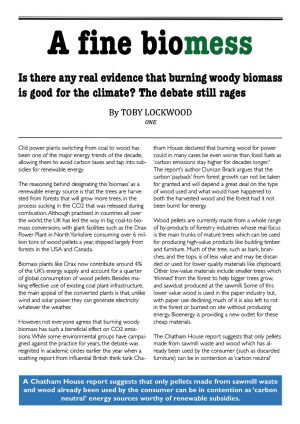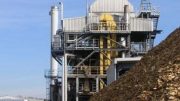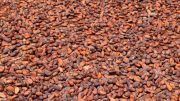 Old power plants switching from coal to wood has been one of the major energy trends of the decade, allowing them to avoid carbon taxes and tap into subsidies for renewable energy.
Old power plants switching from coal to wood has been one of the major energy trends of the decade, allowing them to avoid carbon taxes and tap into subsidies for renewable energy.
The reasoning behind designating this ‘biomass’ as a renewable energy source is that the trees are harvested from forests that will grow more trees, in the process sucking in the CO2 that was released during combustion. Although practised in countries all over the world, the UK has led the way in big coal-to-biomass conversions, with giant facilities such as the Drax Power Plant in North Yorkshire consuming over 6 million tons of wood pellets a year, shipped largely from forests in the USA and Canada.
Biomass plants like Drax now contribute around 4% of the UK’s energy supply and account for a quarter of global consumption of wood pellets. Besides making effective use of existing coal plant infrastructure, the main appeal of the converted plants is that, unlike wind and solar power, they can generate electricity whatever the weather.
However, not everyone agrees that burning woody biomass has such a beneficial effect on CO2 emissions. While some environmental groups have campaigned against the practice for years, the debate was reignited in academic circles earlier this year when a scathing report from influential British think tank Chatham House declared that burning wood for power could in many cases be even worse than fossil fuels as ‘carbon emissions stay higher for decades longer.’
The report’s author Duncan Brack argues that the carbon ‘payback’ from forest growth can not be taken for granted and will depend a great deal on the type of wood used and what would have happened to both the harvested wood and the forest had it not been burnt for energy.
Wood pellets are currently made from a whole range of by-products of forestry industries whose real focus is the main trunks of mature trees which can be used for producing high-value products like building timber and furniture. Much of the tree, such as bark, branches, and the tops, is of less value and may be discarded or used for lower quality materials like chipboard. Other low-value materials include smaller trees which ‘thinned’ from the forest to help bigger trees grow, and sawdust produced at the sawmill. Some of this lower value wood is used in the paper industry but, with paper use declining, much of it is also left to rot in the forest or burned on site without producing energy. Bioenergy is providing a new outlet for these cheap materials.
The Chatham House report suggests that only pellets made from sawmill waste and wood which has already been used by the consumer (such as discarded furniture) can be in contention as ‘carbon neutral’ energy sources worthy of renewable subsidies. It argues that any residues which would otherwise be left to decay in the forest represent a much slower release of carbon than in combustion for bioenergy, and can even help other tree growth by providing nutrients. Other potential uses as low-quality materials would also mean ‘locking up’ the carbon for longer. This idea of the time-scale of the CO2 release is central to the report’s argument, which subscribes to the idea that release of a lot of CO2 in the short term could have a dangerous effect on the climate, even if it is reabsorbed in a few decades time. The report also expresses concern that bioenergy products can have a detrimental effect on the total carbon stored in the forest, noting research which shows that old trees actually absorb more CO2 than younger trees.
The Chatham House report led to a furious response from a number of biomass research groups, including the International Energy Agency’s Bioenergy group, which claimed the policy recommendations were based on ‘unsubstantiated claims and flawed arguments.’ Most critics of the research have emphasised that wood pellets for power generation account for a tiny fraction of forestry products (1% in the USA), and that the low-value product has a negligible impact on forestry practices.
As pointed out by the UK’s ‘Supergen’ bioenergy research group, a 100% price increase in wood pellets has in the past led to only a 3% growth in the US harvest. They also stress that, while CO2 may be released by harvesting one part of a forest or ‘stand’ of trees, trees growing elsewhere mean that the whole forest remains a constant store of carbon, and there is no real ‘delay’ in getting back the CO2. Supporters of woody biomass point out that forests in the US have grown in recent years.
Not to be deterred, Chatham House replied to the IEA riposte with some indignation, standing by their original findings and remarking that it is unprecedented for an intergovernmental panel to demand they withdraw their policy advice.
At the heart of the disagreement between the two sides of the debate seems to be different ways of looking at the standard bioenergy needs to achieve to be truly sustainable. Chatham House doesn’t dispute that a harvested forest can hold a constant level of carbon, but maintain that this still isn’t good enough.
Essentially, the argument is that untouched forest is better for the climate than a managed forest, so any risk of the bioenergy industry increasing the existing harvest should be avoided, and definitely not subsidised as a renewable energy source. Their opponents insist that wood pellets are not making a difference to harvests anyway, and may even be having a beneficial effect by helping keep forestries in business in places where they would not otherwise exist. On a more scientific note, the two sides also have different views on whether ‘natural’ forest is, in fact, better for the climate, with some bioenergy supporters arguing that forestries promote healthy, large trees which absorb more CO2.
Even if there is no effect on the rate of harvest at all, Chatham House point out that we need to look more closely at what would happen if the low-value wood were not used for bioenergy. This is where the issue of the time-scale of CO2 release comes in, as keeping the carbon in low-quality materials or rotting on the forest floor at least postpones the CO2 emissions for a while and lessens the chance of reaching a critical level of CO2 in the next decade or two. The supporters of bioenergy hold that the great majority of this material either decays very rapidly or is burnt on site, without producing energy.
It is important to realise that the European Union and countries like the UK and the Netherlands already have fairly strict rules on the sustainability of biomass sources. While Chatham House would like these to take better account of how bioenergy is affecting overall forest stocks, there are indications that regulations are already moving in this direction in Europe. On the other hand, there is always the problem of how to deal with biomass sourced from countries which don’t account for greenhouse gas emissions from land use so rigorously.
The think tank suggest that one approach would be to stop treating the CO2 emissions from biomass power plants as zero, and instead require that the ‘negative’ CO2 is properly accounted for by the country selling the wood pellets. However, many are strongly opposed to this idea, as it could destroy the viability of the whole industry.
Bioenergy scientists have been addressing the issue of sustainability for many years, and they claim that the points made by Chatham House are not new questions. However, as the industry grows in scale and has more potential to influence forestry, both sides seem to agree that we must continue to scrutinise the practice, and develop new and better regulations.
Meanwhile, UK government policy appears to have cooled towards further coal-to-biomass conversions, perhaps in recognition of the fact that sustainability issues may become a problem if it continues to grow at such a rate. If other countries seek to follow in the UK’s footsteps, we will need to keep a close eye on how biomass is really affecting CO2 emissions.
Toby Lockwood





